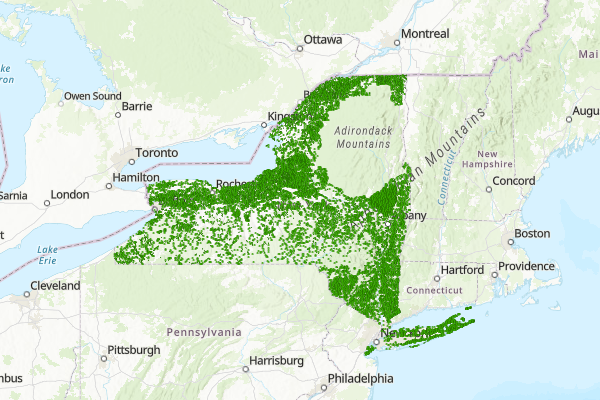
Agricultural districts in New York serve as the backbone of the state’s thriving farming community, protecting and promoting the availability of land for agricultural purposes.
These districts have been established in multiple counties across New York to support and safeguard the interests of local farmers and agricultural businesses.
The boundaries of these agricultural districts are meticulously defined, corresponding to 1:24,000-scale maps produced at county agencies, ensuring the preservation and accessibility of farmland for farming activities.
By exploring the role of agricultural districts, understanding their historical significance, and delving into their economic impact, we can gain valuable insights into the vital contributions they make to New York’s agricultural sector.
Furthermore, we will uncover the benefits and incentives available to landowners within agricultural districts, shedding light on the advantages of being part of these designated areas and the support they provide to farming communities.
To provide a comprehensive understanding of agricultural districts, this post will refer to relevant studies and publications from Cornell University’s CUGIR collection, offering authoritative insights and valuable resources for readers interested in the growth and preservation of agricultural districts in New York.
Definition of Agricultural Districts
Agricultural districts in New York play a pivotal role in maintaining a supportive operating environment for farm businesses, thus significantly contributing to the state’s agricultural sector.
Importance of Agricultural Districts in New York’s Economy
These districts are crucial in preserving farmland, protecting agricultural resources, and providing vital support to farming communities. By creating a conducive environment for farm businesses, agricultural districts are key to sustaining the economic growth and stability of New York’s agricultural sector.
Agricultural districts are a product of legislative efforts to protect farmers against local laws that could hinder their farming operations. The application and request for review procedures ensure that farmers have the necessary protection to continue their agricultural activities without undue restrictions.
To delve deeper into the legal framework and creation process of agricultural districts in New York, one can explore historical documents or legislative frameworks from Cornell University’s CUGIR collection.
For a comprehensive understanding of the significance of agricultural districts in New York’s economy, click here to access relevant information from the New York State Department of Agriculture and Markets.
Historical Background

Agricultural districts in New York have a rich historical background, shaped by legislative frameworks and a detailed creation process. The origins of these districts can be traced back to the enactment of Article 25-AA of the Agriculture & Markets Law in 1971, demonstrating the state’s commitment to protecting and promoting the availability of land for farming purposes.
Legislative Framework and Creation Process
The legislative framework for creating agricultural districts in New York is defined by Article 25-AA of the Agriculture & Markets Law. This legislation outlines the process by which counties can establish agricultural districts, with a specific focus on protecting and preserving viable agricultural land.
The creation process involves a thorough assessment of geographic areas consisting predominantly of viable agricultural land, taking into account factors such as agricultural businesses, development pressures, and regulatory constraints.
To delve deeper into the legislative framework and creation process of agricultural districts in New York, it’s essential to understand the legal aspects and procedural requirements outlined in Article 25-AA. By doing so, stakeholders gain insights into the comprehensive approach taken to safeguard the state’s agricultural resources and support the farming communities within these designated districts.
For more information about the historical background and legislative framework of agricultural districts, you can refer to this publication on New York’s Agricultural Districts, offering a comprehensive overview of the creation and maintenance of these vital agricultural zones.
To further explore the legislative framework, the Agricultural Districts Law: A Current Summary provides an in-depth understanding of the significant role played by the Agricultural Districts Program in preserving farmland in New York.
By understanding the historical aspects and legislative foundations of agricultural districts in New York, individuals can gain a deeper appreciation for the vital role these districts play in sustaining the state’s agricultural heritage and fostering the growth of farming communities.
Role of Agricultural Districts
Agricultural Districts in New York play a crucial role in preserving the state’s farmland and supporting the farming communities.
These districts are designed to protect and promote the availability of land for farming purposes, benefiting farmers and owners of farmland while contributing significantly to the state’s economy.
Let’s delve into the specific aspects of their role:

Preservation of Farmland
Agricultural Districts are instrumental in preserving farmland from non-agricultural development. By designating specific areas as agricultural districts, the state can safeguard these lands for farming purposes, ensuring the continuity of agricultural activities and preventing urban sprawl from encroaching on vital agricultural resources. This preservation is essential for maintaining the state’s agricultural heritage and ensuring a sustainable future for farming.
Protection of Agricultural Resources
These districts serve as protective zones for agricultural resources, such as fertile soils, water sources, and open spaces, that are vital for successful farming operations. By establishing Agricultural Districts, New York aims to shield these resources from competing land uses, urbanization, and environmental degradation, thereby promoting the long-term viability of the agricultural industry.
Support for Farming Communities
Agricultural Districts provide a supportive environment for farming communities by creating a cohesive network of agricultural activities. They foster collaboration among farmers, promote agricultural education and outreach, and facilitate the sharing of best practices.
Additionally, these districts contribute to the overall resilience of farming communities by providing a structured framework for addressing common challenges and leveraging collective strengths.
As we explore the role of Agricultural Districts in New York, it becomes evident that their impact extends beyond land protection. They are an integral part of the state’s agricultural landscape, fostering sustainable practices, preserving agricultural heritage, and contributing to the well-being of farming communities and the broader economy.
For more in-depth information about Agricultural Districts, you can refer to resources such as Agricultural Districts from the New York State Department of Agriculture and Markets and A Current Summary of the Agricultural Districts Law that provide valuable insights into the legislative framework and practical implementation of these districts.
Stay tuned as we further explore the historical background, economic impact, and challenges associated with Agricultural Districts in New York.
Economic Impact

Agricultural districts have a substantial economic impact on the state of New York. The contribution of these districts to New York’s agricultural sector is significant, stimulating rural development and job creation, ultimately playing a pivotal role in the state’s economic landscape.
Contribution to New York’s Agricultural Sector
New York’s agricultural industry is a resilient and integral part of the state’s economy, supporting jobs and communities throughout the state. The agriculture industry contributes significantly to employment, incomes, and tax revenues across the Empire State (source). In 2021, agriculture in New York contributed $43.6 billion in total industry output, reflecting its substantial economic influence (source).
Stimulating Rural Development and Job Creation
Agricultural districts play a crucial role in stimulating rural development and job creation across New York state. The consolidation of agricultural districts, designed in part to protect farmers and keep the industry viable, has positively impacted the agricultural landscape (source).
In 2019, agricultural industries, including production, support services, and manufacturing, directly contributed to job creation and economic growth (source).
Agricultural districts not only contribute to the economic vitality of New York’s agricultural sector but also play a crucial role in sustaining and expanding employment opportunities in rural areas.
Benefits for Landowners
The establishment of agricultural districts in New York presents significant advantages for landowners, ranging from tax incentives to protection from non-agricultural development.

Tax Incentives and Exemptions
Landowners within agricultural districts are eligible for various tax incentives and exemptions as part of the state’s efforts to support and promote agricultural activities. The Agricultural Districts Law allows reduced property tax bills for land in agricultural production by limiting the property tax assessment.
This provides financial relief to landowners engaged in farming activities, contributing to the sustainability of agricultural operations and the preservation of farmland. Additionally, for newly constructed or reconstructed agricultural structures, New York’s Real Property Tax Law allows a ten-year property tax exemption. These incentives aim to alleviate the financial burden on landowners and encourage the continued use of land for agricultural purposes.
Protection from Non-Agricultural Development
One of the key benefits of being located within an agricultural district is the protection from non-agricultural development. Agricultural districts provide landowners with safeguards and zoning protections that help prevent their land from being converted to non-agricultural uses. This not only preserves the agricultural landscape but also maintains the rural character of the area, ensuring that farmlands remain dedicated to agricultural production.
As a result, landowners within agricultural districts can have greater peace of mind regarding the long-term preservation of their properties for farming and related activities.
These benefits create a favorable environment for landowners within agricultural districts, encouraging the continued cultivation and utilization of farmland for agricultural purposes while offering financial support and protection against non-agricultural encroachment.
For those considering the purchase of land for farming or related ventures in New York, understanding the advantages associated with agricultural districts is crucial for making informed decisions and leveraging available support mechanisms.
Platforms such as WeSellNewYorkLand.com provide valuable resources for landowners within agricultural districts, offering insights into tax incentives, zoning regulations, and opportunities for buying or selling land tailored for farming.
Challenges and Future Outlook

Agricultural districts in New York face several challenges in the current landscape, impacting their sustainability and growth. Understanding these challenges and strategizing for the future is crucial for ensuring the continued success of agricultural districts in the state.
Pressures on Agricultural Districts
Challenges arise from various sources, including urban encroachment, rising land prices, and regulatory complexities. Urban development can exert pressure on farmlands, leading to their conversion for non-agricultural purposes.
This threatens the availability of land for farming within agricultural districts. Moreover, as land values appreciate, farmers and landowners face difficulties in maintaining their holdings, posing a risk to the continuity of agricultural activities.
Sustainable agricultural practices also face hurdles due to changing environmental conditions and climate variability. Factors such as extreme weather events and shifts in precipitation patterns can impact crop yields and livestock management, affecting the overall viability of farming within these districts.
Strategies for Sustainable Growth and Preservation
To address these challenges and secure the future of agricultural districts in New York, a multi-faceted approach is necessary. Implementing zoning regulations that protect agricultural lands from urban sprawl is vital. Encouraging the adoption of sustainable farming techniques and resource-efficient practices can enhance the resilience of agricultural districts.
Supporting land protection programs and conservation easements plays a crucial role in preserving farmlands within these districts. It is essential to engage in community outreach and education to promote awareness about the significance of preserving agricultural districts and the benefits they offer to local economies and food systems.
Partnerships with governmental agencies, non-profit organizations, and private stakeholders can facilitate the establishment of initiatives aimed at sustaining agricultural districts. These collaborations can lead to the development of policies that provide incentives for farmers and landowners to engage in environmentally friendly practices and contribute to the long-term sustainability of agricultural districts.
By focusing on these strategies, agricultural districts can overcome current challenges and envision a future characterized by vibrant, resilient farming communities and preserved farmlands that are integral to New York’s agricultural heritage and economic prosperity.
For further insights on the challenges faced by agricultural districts and strategies for sustainable growth, refer to relevant research at Cornell University’s CUGIR collection.
Addressing challenges related to urban encroachment and land prices can be facilitated through platforms like WeSellNewYorkLand.com, where landowners can connect with potential buyers or lessees interested in maintaining agricultural activities within designated districts.
Case Studies
Agricultural districts in New York exhibit diverse and impactful case studies that underscore their critical role in sustaining the state’s agricultural landscape and rural communities.
These case studies provide real-world examples of how agricultural districts have positively influenced farming practices, economic growth, and community resilience.

Successful Agricultural Districts in New York
Case Study 1: Soil Health and Farm Profitability
A New York farm was featured in a comprehensive case study conducted by the American Farmland Trust and USDA NRCS, highlighting the significant economic and environmental benefits of soil health efforts. The study demonstrates how investments in soil health can enhance farm profitability and sustainability, serving as a valuable resource for farmers seeking to adopt best practices.
Case Study 2: Urban Agriculture Initiatives
The Agricultural Resources in New York State report showcases urban agriculture case studies from Albany, Buffalo, New York City, Rochester, and Syracuse. These case studies provide insights into the successful integration of agricultural activities within urban settings, emphasizing the diverse approaches to leveraging limited space for agricultural purposes and fostering local food production.
Case Study 3: Impact of Agricultural Districts
A comprehensive study delves into New York State’s Agricultural Districts, shedding light on the tangible benefits and challenges faced by certified agricultural districts. By examining specific farming communities within these districts, the study emphasizes the pivotal role of this designation in protecting farmland, promoting sustainable agricultural practices, and supporting farm viability amidst urban encroachment.
Impact on Local Communities and Farming Families
Case Study 4: Clean Energy Projects
NYSERDA’s Program and Initiative Case Studies feature impactful examples of clean energy projects deployed across New York. These case studies illustrate the collaborative efforts between agricultural stakeholders and energy initiatives, emphasizing the pivotal role of agricultural districts in supporting sustainable energy practices and enhancing rural development.
Case Study 5: Right to Farm Laws
A legal analysis explores the implications of New York State’s Right to Farm laws within agricultural districts, providing nuanced insights into the legal protections afforded to farming families and the potential tensions arising from urban-rural interfaces. This case study underscores the intricate interplay between agricultural districts, legislative frameworks, and the preservation of farming traditions.
These case studies collectively highlight the multifaceted impact of agricultural districts on local communities, environmental conservation, economic sustainability, and the preservation of New York’s rich agricultural heritage.
For further in-depth exploration of case studies related to agricultural districts in New York, you can refer to the Agricultural Districts (NYS Ag and Markets) collection.
Conclusion
Agricultural Districts serve as the growth engine of New York, playing a crucial role in preserving farmland, supporting farming communities, and promoting the availability of land for agricultural purposes.
These districts provide essential protections and benefits to landowners, ensuring the continuation of farming and the safeguarding of agricultural lands. It is imperative for both current and prospective landowners to understand the significance of Agricultural Districts and actively support their preservation.
By recognizing and advocating for the importance of these districts, individuals can contribute to the sustainable growth and prosperity of New York’s agricultural sector.
For more information about the benefits of agricultural districts for landowners, you can refer to the following resources:

- New York State Department of Agriculture and Market
- CUGIR collection
- New York’s Agricultural Districts
- Benefits of Agricultural Districts
- Benefits of Being in Agricultural District
- Overview of District Benefits | Wayne County, NY
- Agricultural District Review Frequently Asked Questions
- Agricultural assessment program: overview
- Landowner Guide
- Tax Credits and Agricultural Assessments
- New York agricultural assessment in a nutshell
- Who gets a property tax break for farming in NY? Search …

